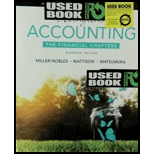
Horngren's Accounting, The Financial Chapters (11th Edition) - Standalone Book
11th Edition
ISBN: 9780133866889
Author: Tracie L. Miller-Nobles, Brenda L. Mattison, Ella Mae Matsumura
Publisher: PEARSON
expand_more
expand_more
format_list_bulleted
Concept explainers
Textbook Question
Chapter 1, Problem E1.33E
Use the following information to answer Exercises E1−31 through E1−33.
The account balances of Wilford Towing Services at June 30, 2016, follow:
| Equipment |
$ 17,500 |
Service Revenue |
$ 13,000 |
| Office Supplies |
1,300 |
8,200 |
|
| Notes Payable |
6,900 |
Accounts Payable |
6,000 |
| Rent Expense |
800 |
Wilford, Capital, June 1, 2016 |
7,700 |
| Cash |
1,900 |
Salaries Expense |
1,900 |
| Wilford Withdrawals |
2,000 |
E1-33 Preparing the
- Prepare the balance sheet for Wilford Towing Service as of June 30. 2016
- What does the balance sheet report?
Expert Solution & Answer
Want to see the full answer?
Check out a sample textbook solution
Students have asked these similar questions
I am trying to find the accurate solution to this general accounting problem with the correct explanation.
Can you solve this general accounting problem using accurate calculation methods?
I am trying to find the accurate solution to this general accounting problem with the correct explanation.
Chapter 1 Solutions
Horngren's Accounting, The Financial Chapters (11th Edition) - Standalone Book
Ch. 1 - Prob. 1QCCh. 1 - Which of the following is not an external user of...Ch. 1 - Prob. 3QCCh. 1 - Prob. 4QCCh. 1 - Prob. 5QCCh. 1 - Which of the following requires accounting...Ch. 1 - At the end of a recent year, Global Cleaning...Ch. 1 - Consider the overall effects on Global Cleaning...Ch. 1 - Assume that Global Cleaning Service performed...Ch. 1 - The balance sheet reports the Learning Objective 5...
Ch. 1 - Assume Global Cleaning Service had net income of...Ch. 1 - What is accounting?Ch. 1 - Prob. 2RQCh. 1 - Prob. 3RQCh. 1 - Prob. 4RQCh. 1 - Prob. 5RQCh. 1 - Prob. 6RQCh. 1 - Prob. 7RQCh. 1 - A business purchases an acre of land for $5,000....Ch. 1 - What does the going concern assumption mean for a...Ch. 1 - Which concept states that accounting information...Ch. 1 - Financial statements in the United States are...Ch. 1 - Prob. 12RQCh. 1 - What is the accounting equation? Briefly explain...Ch. 1 - What are two ways that equity increases? What are...Ch. 1 - How is net income calculated? Define revenues and...Ch. 1 - What are the steps used when analyzing a business...Ch. 1 - List the four financial statements. Briefly...Ch. 1 - What is the calculation for ROA? Explain what ROA...Ch. 1 - Prob. S1.1SECh. 1 - Determining organizations that govern accounting...Ch. 1 - Identifying types of business organizations...Ch. 1 - Prob. S1.4SECh. 1 - Applying accounting assumptions and principles...Ch. 1 - Prob. S1.6SECh. 1 - Prob. S1.7SECh. 1 - Identifying accounts Learning Objective 3 Consider...Ch. 1 - Prob. S1.9SECh. 1 - Using the accounting equation to analyze...Ch. 1 - Identifying accounts on the financial statements...Ch. 1 -
I rhr JoUou'ing ittfonnatioH to antovr Short...Ch. 1 -
I rhr JoUou'ing ittfonnatioH to antovr Short...Ch. 1 - Irhr JoUou'ing ittfonnatioH to antovr Short...Ch. 1 - Prob. S1.15SECh. 1 - Prob. S1.16SECh. 1 - Prob. E1.17ECh. 1 - Prob. E1.18ECh. 1 - 1. Accounting equation a. An economic resource...Ch. 1 - Prob. E1.20ECh. 1 - Prob. E1.21ECh. 1 - Prob. E1.22ECh. 1 - Prob. E1.23ECh. 1 - Prob. E1.24ECh. 1 - Using the accounting equation to analyze...Ch. 1 - Using the accounting equation to analyze business...Ch. 1 - Using the accounting equation to analyze business...Ch. 1 - Using the accounting equation to analyze business...Ch. 1 - Prob. E1.29ECh. 1 - Preparing the financial statements Learning...Ch. 1 - Prob. E1.31ECh. 1 - Prob. E1.32ECh. 1 - Use the following information to answer Exercises...Ch. 1 - Prob. E1.34ECh. 1 - Prob. E1.35ECh. 1 - Prob. E1.36ECh. 1 - Prob. E1.37ECh. 1 - Prob. E1.38ECh. 1 - Prob. E1.39ECh. 1 - Prob. P1.40APGACh. 1 - Prob. P1.41APGACh. 1 - Prob. P1.42APGACh. 1 - Prob. P1.43APGACh. 1 - Prob. P1.44APGACh. 1 - Prob. P1.45APGACh. 1 - Prob. P1.46APGACh. 1 -
Astm
< ->»l 1 • ptl « I Sb
•ArtA* V...Ch. 1 - Prob. P1.48BPGBCh. 1 - PI »9K Preparing financial »uifmrnn I’kvx-nii.i...Ch. 1 - PI-SOB Preparing financial italtmmu Precision Pies...Ch. 1 - Prob. P1.51BPGBCh. 1 - Prob. P1.52BPGBCh. 1 - 1*1 S 4H I *it»g the jsi nmn|i equation foi...Ch. 1 - || V. , -
«••••"“ -
4 «k»wl Ml*«...Ch. 1 - Decision Case 1-1 Let’s examine a case using...Ch. 1 - The tobacco companies have paid billions because...Ch. 1 - Prob. 1.1FCCh. 1 - Prob. 1.1FSC
Knowledge Booster
Learn more about
Need a deep-dive on the concept behind this application? Look no further. Learn more about this topic, accounting and related others by exploring similar questions and additional content below.Similar questions
- Can you help me solve this general accounting question using the correct accounting procedures?arrow_forwardCan you solve this general accounting question with accurate accounting calculations?arrow_forwardPlease help me solve this financial accounting problem with the correct financial process.arrow_forward
arrow_back_ios
SEE MORE QUESTIONS
arrow_forward_ios
Recommended textbooks for you
 Cornerstones of Financial AccountingAccountingISBN:9781337690881Author:Jay Rich, Jeff JonesPublisher:Cengage Learning
Cornerstones of Financial AccountingAccountingISBN:9781337690881Author:Jay Rich, Jeff JonesPublisher:Cengage Learning College Accounting, Chapters 1-27 (New in Account...AccountingISBN:9781305666160Author:James A. Heintz, Robert W. ParryPublisher:Cengage Learning
College Accounting, Chapters 1-27 (New in Account...AccountingISBN:9781305666160Author:James A. Heintz, Robert W. ParryPublisher:Cengage Learning Financial AccountingAccountingISBN:9781305088436Author:Carl Warren, Jim Reeve, Jonathan DuchacPublisher:Cengage Learning
Financial AccountingAccountingISBN:9781305088436Author:Carl Warren, Jim Reeve, Jonathan DuchacPublisher:Cengage Learning

Cornerstones of Financial Accounting
Accounting
ISBN:9781337690881
Author:Jay Rich, Jeff Jones
Publisher:Cengage Learning

College Accounting, Chapters 1-27 (New in Account...
Accounting
ISBN:9781305666160
Author:James A. Heintz, Robert W. Parry
Publisher:Cengage Learning

Financial Accounting
Accounting
ISBN:9781305088436
Author:Carl Warren, Jim Reeve, Jonathan Duchac
Publisher:Cengage Learning

The accounting cycle; Author: Alanis Business academy;https://www.youtube.com/watch?v=XTspj8CtzPk;License: Standard YouTube License, CC-BY